Power creep is common in TCG’s, and it’s something that most games experience — at least games with a live model, or a model that involves multiplayer interaction and new elements of design. Power creep in Magic has, by and large, been quite slow given the game has been going for more than 25 years.
Power Creep in Magic
This article could have easily been titled “Spotting Signs of Power Creep in Magic,” but in calling it that, I’d have had to look at the topic from a different viewpoint. There’s also the fact that this blog post already exists, which summarizes the key historical changes to the game. It’s a great read, so do check it out (whether you agree with the argument or not).
That said, I’ll briefly go over the two major milestones when it comes to power creep in Magic that have brought us to where we are today. The first was the shift away from stack-based gameplay toward the now standard creature-based gameplay. This was made possible by increasing the rate on creatures, commonly by giving them powerful enter the battlefield abilities. It was done to make the game less complex and more accessible.
The second, in my opinion, was the shift toward designing cards for 1v1 Best-of-One matches on Arena. These cards had to either be modal or replace themselves (by drawing a card) in order to help “smooth out” games and leave less dead cards.
Power Creep in Commander
This article is about spotting power creep in Commander, though — and while I will point out different signs to the ones you’ll see in other Constructed formats, there is some crossover. Having a thorough grounding in the concept will help to contextualize things going forward. Without any further ado, let’s get into it.
Mana Rocks That Do Stuff
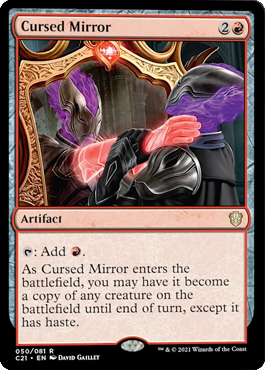
The first — and most obvious — sign is the increased utility of mana rocks. Mana rocks are a key component of decks in Commander, and part of what makes the format so unique. Sure, you use them in Vintage too, I guess, but you get my point. Decks will always have a certain amount of ramp, and for the most part, this will involve mana rocks.
Cursed Mirror, above, is one of the more recent examples. Not only will it help you ramp, but it’ll also give you some serious value when it comes in. Quadrant Theory dictates there are four stages of a game where a card can be evaluated: developing, ahead, behind, or at parity. Traditionally, mana rocks have been pretty great when developing, decent when at parity, forgettable when you’re ahead, and begrudgingly playable to straight up bad when you’re behind.
Cursed Mirror fixes this. When you’re behind, it can give you a great ETB or attack trigger to help get you back to parity. And when you are ahead, or at parity? This breaks the game wide open, allowing you extra triggers and a snowball effect. It’s like putting cycling on a card, but so much better when your board is developed.

Just last week I got to get a second Archon of Cruelty trigger when playing Chainer, netting me incredible value for a measly three mana. I love the card, but it’s a glaring example of power creep when it comes to Commander.
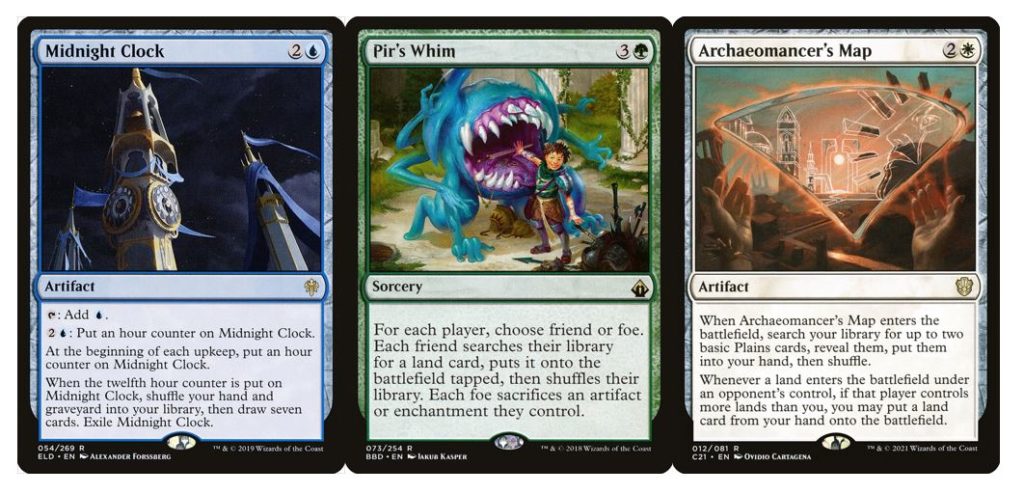
Cursed Mirror isn’t alone. We’ve moved pretty far from original Commander rocks like Unstable Obelisk and Commander’s Sphere, and nowadays mana rocks — and adjacent spells — are lining up to give you better effects. Midnight Clock offers a hand refresh; Pir’s Whim removal; Archaeomancer’s Map repeatable catch-up ramp after drawing you two lands from the deck. All of these cards seek to improve the consistency of decks, and all do so by effectively replacing existing cards. We were all quick to replace Explosive Vegetation with Migration Path, after all.
Paying Life instead of Mana
They say that whoever spends the most mana wins games, and this is largely true. Making land drops and keeping cards flowing is key, and anything that lets you cheat on mana is generally worth playing.

While the first thing that springs to mind when cheating mana is mentioned is usually the degenerate ways to do it, they’re far from the only ways. We all cheat on mana in Commander, whether from cost-reducing effects or by playing synergies that help us do things that usually require mana to pull off.
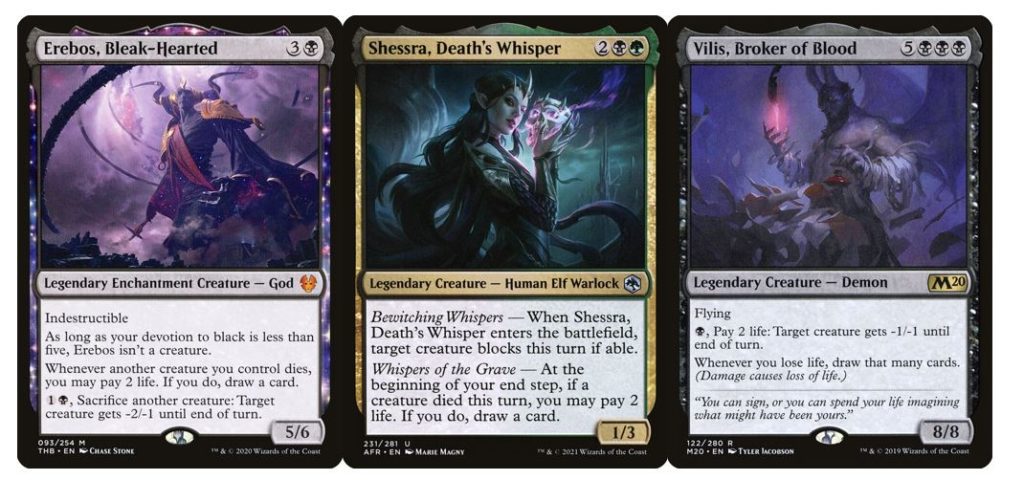
Most recently, I’ve noticed how much potential there is in drawing cards without paying mana. I mean, duh, right? While yes, drawing cards without spending mana is obviously great, I want to be specific here. Cards like the new Erebos and Shessra from Adventures in the Forgotten Realms give you repeatable triggers to draw cards, and all they ask is a little life in exchange. You have plenty of life in Commander; it’s why Necropotence and Ancient Tomb are so good.
What makes these cards so good is that they trigger passively while you get on with doing different things. While Guardian Project has you needing creatures to enter to get the card, Erebos can help you cash in on a board wipe just by sitting there smugly in the corner.
Vilis takes this to the logical endpoint, and just straight up gives you cards for losing life. While paying life to do things has always been a thing for black cards, it’s the ease and rate that new cards offer which prompts us to evaluate this as power creep.
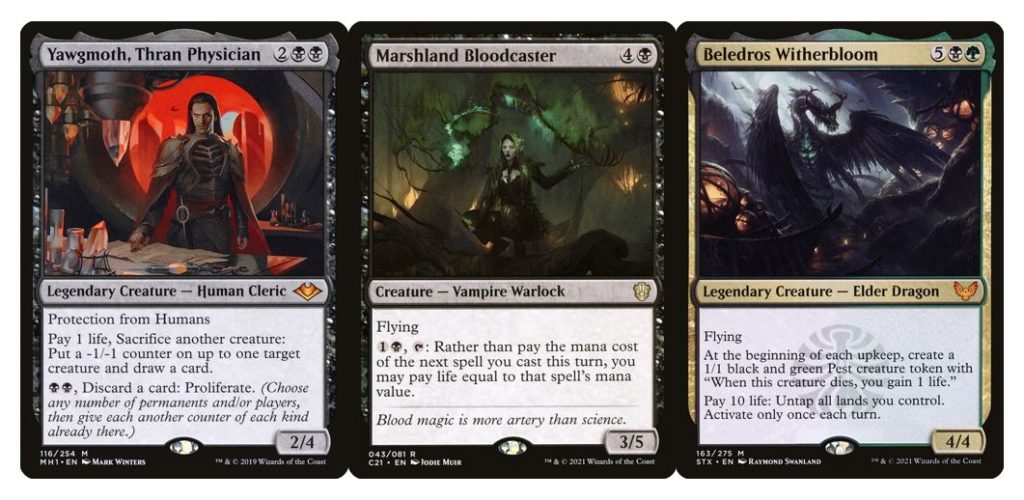
In previous years, Yawgmoth’s activated ability could easily have cost one or even two mana to activate. Marshland Bloodcaster and Beledros Witherbloom give access to huge amounts of mana if you pay the life — a massive jump from previous mana generation, which usually required cards, mana, and/or creatures to pull off.
One-Drops with Text Boxes
While some one-drops have always been good in Commander — Serra Ascendant, Llanowar Elves, Viscera Seer — they’ve become increasingly complex in recent years, and increasingly playable.
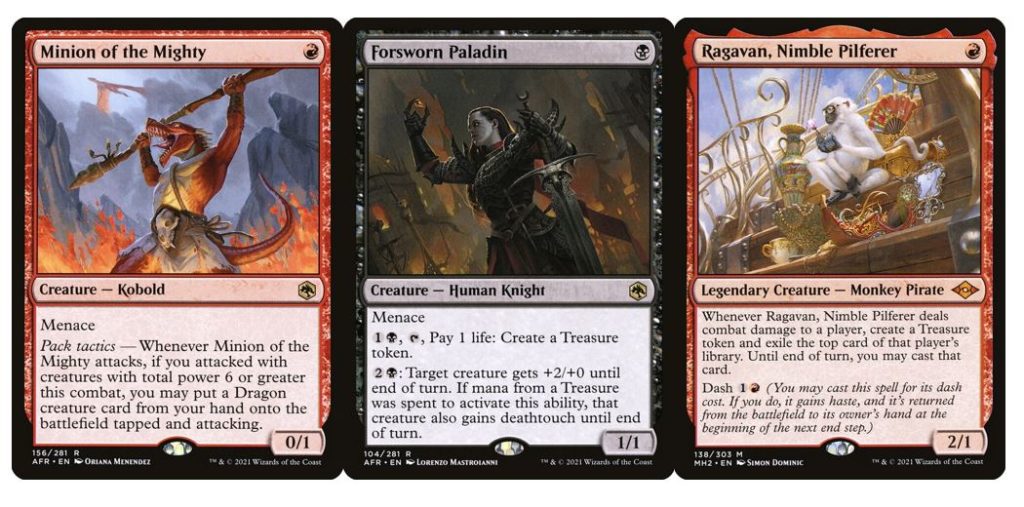
Just in the last two releases, we’ve had a barrage of impressive one-drops to consider, and that’s not even counting Dragon’s Rage Channeler (a cEDH-playable performer) and new Merfolk toys Tide Shaper and Rishadan Dockhand. Powerful one-drop creatures is where Commander converges with Standard when it comes to power creep.
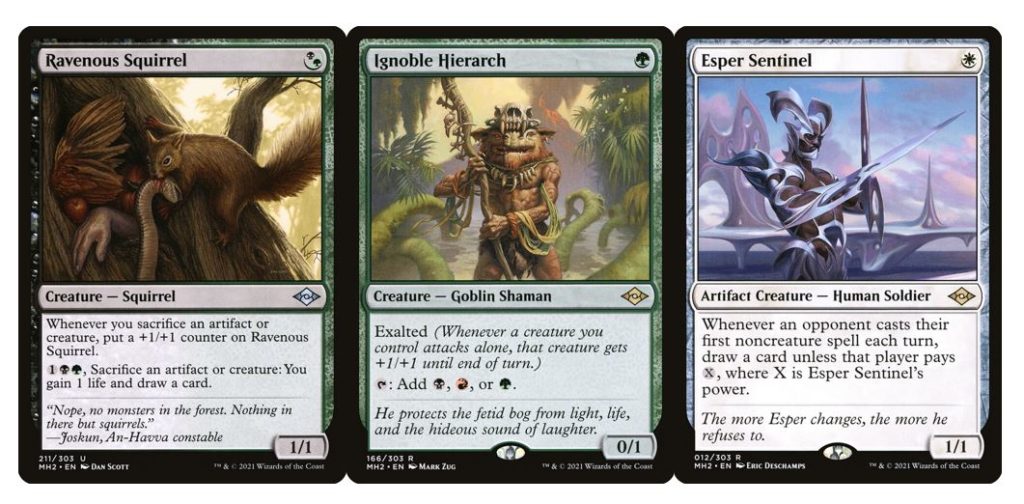
Generally speaking, when it comes to Commander, decks try to avoid playing too many low-impact creatures because they don’t attack or block well, and they get outclassed by more mana-intensive plays. There’s also the fact that a board wipe is likely to come down between turns four and six, so all in all? Not amazing. Back to Quadrant Theory again, and they’re generally unimpressive late in the game, too.
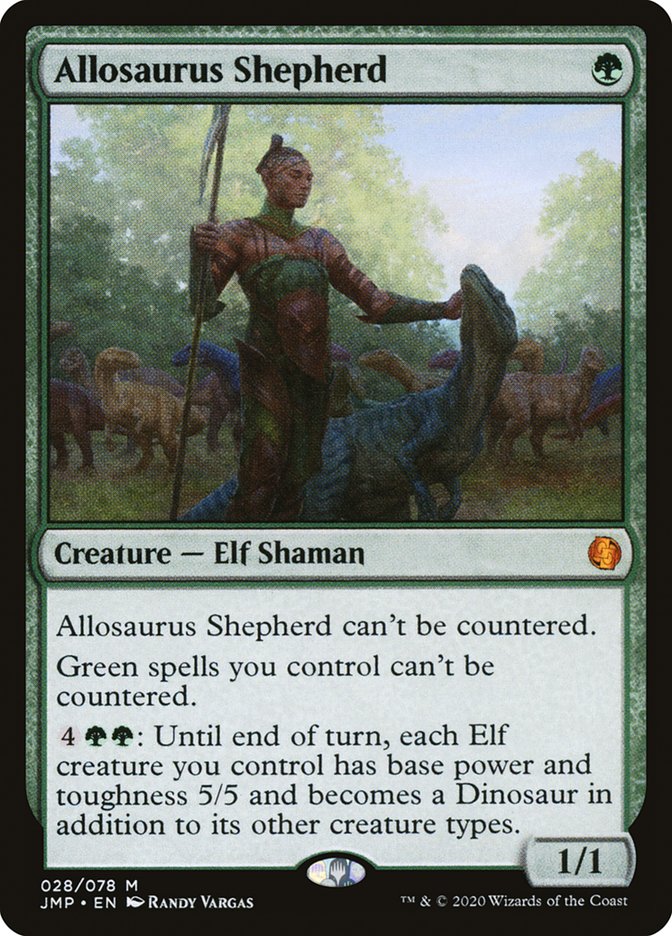
So why are there so many more playable one-drops now than ever before? Well, power creep. These cards are good in more stages of a game than old-fashioned one-drops. They can replace themselves, or offer more than one mana or one card in value. Does Allosaurus Shepherd have any right to be as good as it is? Not at all. That’s power creep.
Efficiency of Removal
While one-drops being power crept might nod toward a faster format, efficiency of removal signs and seals that notion. Commander has gotten faster, and there are more must-answer permanents than ever before. While previously we’ve all joked about decks that “sneeze” and combo, we’re playing at tables now where everyone has hay fever and a cat allergy.
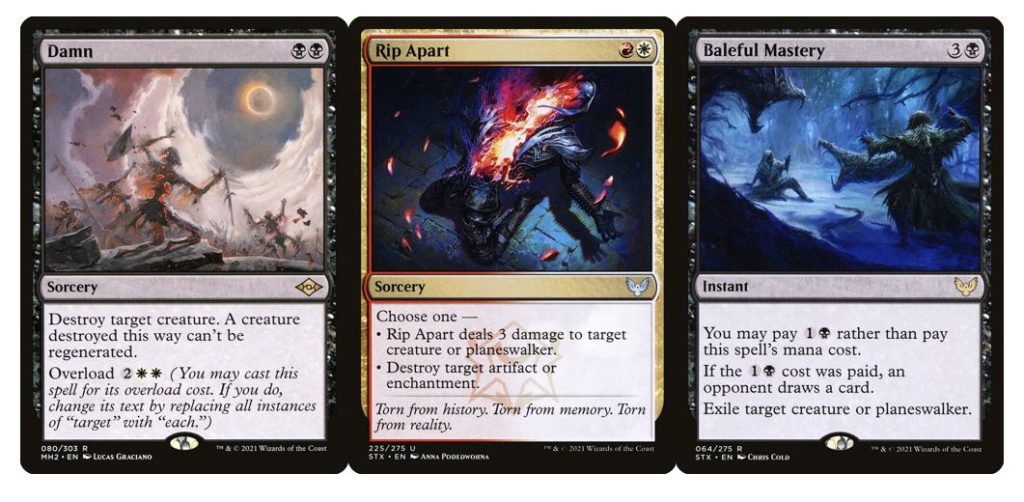
In order to answer more diverse threats at a faster speed, removal has gotten much better. I’ve written before about how Utter End is basically unplayable now, but while sometimes the less efficient spell will be better at more casual levels of play, there’s no denying Wizards is printing some fantastic removal that is usurping older spells.
Damn and Rip Apart are some of the most versatile spells offered to Orzhov and Boros decks in recent times, and Baleful Mastery’s downside of giving an opponent a card is largely forgettable. If you’re answering a problem at the table, you’re already currying favor, and giving a card to a player who might be behind cements your position as a good egg™.

These aren’t the only cards worth noting when talking about power creep, though. Mortality Spear is a two-mana spell most of the time in decks that can enable it; Obsidian Charmaw is usually always two mana; Druid of Purification is unsurprisingly one of the most expensive cards in the precon it’s in — pure value!
How Many New Cards are You Running?
While we can go over examples of power creep and pat ourselves on the back for spotting it, the real proof is in the pudding. How many “new” cards are you running in your decks? If we take a cut off of a couple years, the results may surprise you.
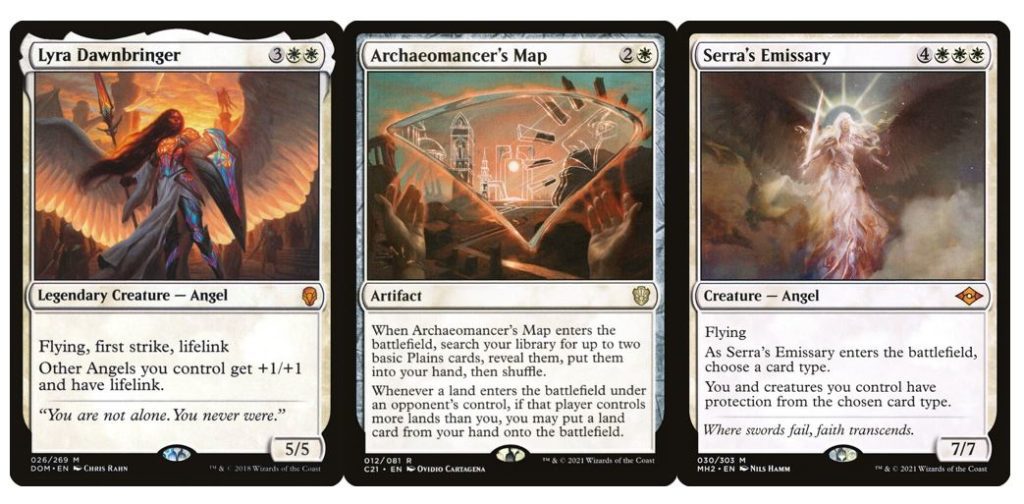
Taking a look at my mono-white Lyra Dawnbringer deck (plus a couple recent edits), I count twenty-four cards printed in 2019 or later. That’s nearly a quarter of the deck, and it’s a deck that wasn’t impossible to build before. This isn’t like Pirate tribal, a tribe that only really got a big burst of support in Commander Legends; this is Angels, a tribe that had a lot of existing “staples” before 2019.
***
Power creep is something we’ll have to get used to in Commander, and it’s a miracle it’s been as slow as it has been. That isn’t to say that it hasn’t sped up considerably in recent years, though; my recent article asking “Where is green headed?” acknowledges this while discussing how to temper power creep through exploring new design spaces.
It’s clear to see that cards are getting better, though. Hopefully this article has helped your card evaluation when it comes to identifying the best cards for upgrading your decks, and the ones to watch out for. Where have you noticed power creep? Let me know on Twitter.

Kristen is Card Kingdom’s Head Writer, and member of the Commander Advisory Group. Formerly a competitive Pokémon TCG grinder, she has been playing Magic since Shadows Over Innistrad, which in her opinion, was a great set to start with. When she’s not taking names with Equipment and Aggro strategies in Commander, she loves to play any form of Limited.

